

The following cartoon appeared on page 19 of the November 1973 edition of ELECTRIC VEHICLE NEWS (USA):
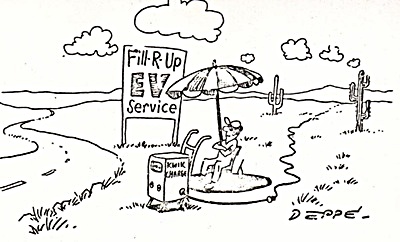

This article was in The Age newspaper:
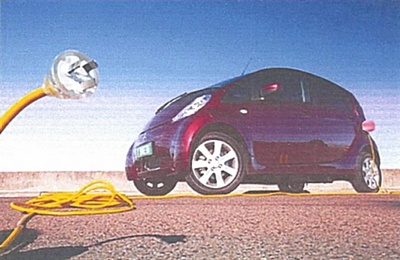
Electric vehicles are making their way on to our roads. We meet some of the people who have adopted the technology.
Bernie Hobbs is a pioneer of Australian motoring. The science broadcaster, best known as a judge on the ABC's New Inventors, is among the first people in this country to ditch her internal combustion-powered car for an all-electric set of wheels.
She is the proud owner of a Blade Electron, a car that starts life as a Hyundai Getz before Victorian-based entrepreneur Ross Blade and his team take out the petrol engine and replace it with an electric motor.
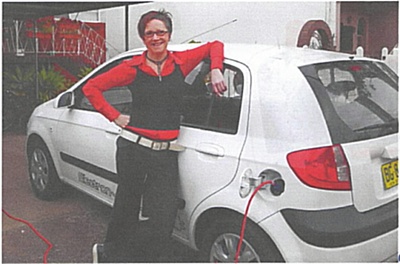
The Blade may be a small operation but make no mistake: electric is on its way. Mitsubishi will have 40 of its i-MiEV electric city car on the road by the end of the year. Nissan is likely to offer the Leaf electric hatchback by 2012.
All-electric plug-in cars are a different breed to petrol-electric hybrids, which use electric motors to supplement a petrol engine and don't require a power outlet.All-electric cars run entirely on batteries and hence need to recharge regularly.Electric cars aren't new - they've been around in some form for almost as long as motor vehicles have been on the road. But recent improvements in battery technology have made them a more realistic alternative to their petrol-engined cousins.There are still big question marks over the charging infrastructure, long-term battery life, safety and resale value of electric vehicles.
But none of this matters to Hobbs; she's happy to have adopted EVs early and faces those challenges head on.
"I've been rabbiting on about the environment for 10 years," she says. "When my old car started getting the shakes I thought, 'I don't want to commit to buying petrol for another 10 years.' So I've put my money where my mouth is."
She admits she considered getting rid of a car altogether and joining a car-sharing program but decided to commit to the Blade and join the electric-car revolution.
"For me, part of the reason I'm doing this is because, with my work, I get to talk about it," she says. "It's normalising the idea of electric cars."
It came at a price, however - $48,000 to be exact - substantially more than a Hyundai Getz with a petrol engine.
But she says it's easy to justify that extra expenditure.
"For me $48,000 is a shitload of money to spend on a car," she says. "But I'm paying for my fuel upfront with the battery pack. So if I keep it for 10 years like my last car, that's $5000 a year. In 10 years I'll probably just give it to my nephew."
For critics of electric cars, Hobbs has switched her energy provider to get "green" energy instead of relying on coal-fired power.
"If you're going to use coal fire you're doing no good, you just have a feel-good car," she says.
"[Switching to green energy] takes you from three tonnes of CO2 per year to none."
She's not the only Australian driver ditching petrol power for electricity. The managing director of Adelaide-based internet service provider Internode, Simon Hackett, not only has a Blade parked in his garage but also just took delivery of the first right-hand drive Tesla Roadster in Australia.
To call Hackett a passionate believer in electric vehicles is an understatement. He has been a fan ever since he drove the GM EV1 in the mid-1990s while working in the US.
He ordered a left-hand-drive Tesla in 2006 but had to wait until 2008 for it to arrive. Last year he set a world record by driving the Roadster more than 500 kilometres on a single charge during the Global Green Challenge.
Hackett bought the Blade Electron as his daily driver because he couldn't register his left-hand-drive Tesla for road use. But with the new Tesla able to be driven on the road, it will replace the Blade as his daily commuter car.
It may have cost Hackett more than $250,000 but as far as he's concerned, it's better than buying a traditional sports car such as a Porsche or Ferrari.
"People say, 'How can it be a sports car if it doesn't go vroom vroom?' You get used to it really quickly," he says.
The first mass-market electric car into Australia, the Mitsubishi i-MiEV, has an official range of 100 kilometres to 160 kilometres before it needs a full recharge (the Hyundai Getz-based Blade claims 100 kilometres).
The challenge for Mitsubishi and its fellow car makers is to convince consumers that 160 kilometres is enough for them to live with.
The Drive team logged its driving habits for a week and found that all of us could comfortably use an electric car with a range of 100 kilometres each day.
But we found on the weekends that range might not be enough to satisfy us all.
Factors such as the weather, driving style and use of the heater and airconditioning all have an impact on the range; just like the fuel consumption in a traditional petrol- or diesel-powered car.
But, unlike a traditional car, topping up the battery of an electric car isn't as simple as ducking into your local service station. Charging an electric car can take up to eight hours and requires a special power outlet.
Both Hobbs and Hackett believe "range anxiety" won't be an issue for most people, providing they live close to their work.
"For the first few days I was shitting myself," Hobbs admits. "But I realised I really never drive more than 100 kilometres."
She does also admit to having a back-up plan.
"I carry a 30-metre extension cord," she says. "That gives me a bit of confidence." Hackett believes it is only a matter of time before electric cars boast a range to match a petrol car. He says he can get more than 300 kilometres from his Tesla regularly and the company's next variant, the Model S, will claim a range of more than 480 kilometres.
"There's this tendency with people to focus on what happens if you run out of electricity. Well, the same thing that happens if you run out of petrol: your car stops," he says. "But what people need to realise is that range, of 100 kilometres or 300 kilometres, is available every day."
Infrastructure for electric cars is very much a case of the chicken and the egg. Car companies have the cars but there isn't any significant infrastructure in place yet. Not surprisingly, no one is interested in installing expensive public charging points for a handful of cars.
Unlike the Blade, some electric cars can't be charged using a regular household outlet - they require a 15-amp plug, the same type used for large airconditioning units.
You can get one installed in your garage or office car park for a few hundred dollars but there are a growing number of operators selling specialised charging points.
ChargePoint Australia is one of the first companies to install a commercially operated roadside outlet, in conjunction with car-sharing company GoGet.
The outlet, in inner-city Glebe, is not available for public use, though; only members of GoGet are able to charge the company's converted Toyota Prius EV.
The joint managing director of ChargePoint, Luke Grana, says the rollout of infrastructure will be a gradual process that will be tied to the amount of EVs on the roads.
"We really see it working with the early adopters like local councils, state governments and fleets," he says. "We won't be rolling out a network until 2013 and we'll be growing with the market."
He believes the most likely scenario will see shopping centres and parking stations emerge as the power provider for electric cars, potentially replacing petrol stations.
In theory, drivers will be able to take their EV to the shops, plug in while they doing their shopping and come back to a fully recharged car.
The first signs of this transition have emerged.
Special parking spaces with power outlets are beginning to pop up around major cities but they are few and far between. So far, shopping centres in Hornsby, Dural and Blacktown have become some of the first to offer electric-car drivers a place to recharge while shopping.
"I think it really needs to be led by the car-consumer marketplace," a spokeswoman for Westfield, Julia Clarke, says.
There are exceptions, though. A new multi-storey structure in downtown Perth has 12 parking spots hard-wired for charging.
To ensure the electricity is sustainable, it's sourced from roof-mounted solar panels.
The car park is overseen by the director of business units for the City of Perth, Doug Forster. He says it will serve as a test ahead of further charging points being set up. The council owns 30 parking stations across the city.
Crucially for the rollout of infrastructure and EVs, federal and state governments have so far shown little tangible support for electric cars. Overseas, governments have offered free parking, access to transit lanes or cash incentives to support early adopters of EVs.
The all-important question, however, is: will car fans miss the vroom of a petrol engine?"I thought I would but I don't," Hackett says. "I've got an old Ferrari, a 1985 308, that's a real work of art. But I can't get motivated to drive it. Once you drive an electric car, you realise you are in a generational-changing vehicle. And I don't miss the generation I'm leaving."
City cars, hatchbacks, sedans and even supercars; there is an electric car suited to almost every need under development somewhere in the world.
• Mitsubishi i-MiEV
The following items were unfortunately not available on the web from The Age newspaper and so had to be scanned. They may be rather difficult to read!

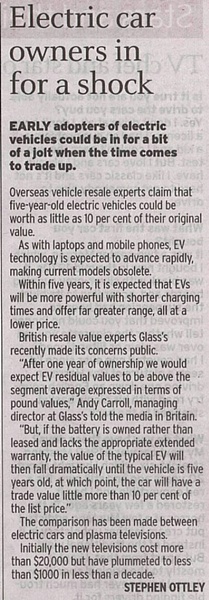

AUSTRALIA'S leading electric car manufacturer has blasted the federal government for choosing an imported model to be Australia's first electric trial fleet.
In June, the federal Minister for Transport and Infrastructure, Anthony Albanese, announced that the government would be buying 40 imported Mitsubishi i-Miev electric vehicles as a way of encouraging the uptake of electric vehicles.
But Castlemaine-based Blade Electric Vehicles said the decision was inexplicable given that its car, the Blade Electron, was better, cheaper, and had been developed with federal government funding.
''We cannot understand why Mr Albanese has chosen to exclude the Electron,'' said Ross Blade, director of BEV.
''The federal government has spent over $100,000 of taxpayers' money on the development of the Blade Electron through the COMET (Commercialising Emerging Technologies) program. Despite the Electron meeting Australia's design standards, the federal government has chosen instead to lease a foreign product at nearly double the cost.''
Mr Blade said that Mitsubishi was leasing the i-Miev for $1740 a month for a total cost over three years of $62,640. This compared with $900 a month for the Electron, for a total cost over three years of $48,000.
Mr Blade said the Electron was a bigger car with superior performance to the i-Miev and, more importantly, could be plugged into a regular power point for recharging.
However, a spokesman for Mr Albanese, Geoff Sinclair, said the government did not choose the Blade Electron because it was not a mass-produced car and did not meet two Australian design standards, although he could not say which ones.
Mr Blade said that if the Australian government was not going to buy a locally made electric car, it stood little chance of being mass produced.
''In terms of our vehicle being mass produced, the fact of the matter is that if the Australian government is not going to buy them, then how can they be mass produced?''It's a chicken and egg thing.''

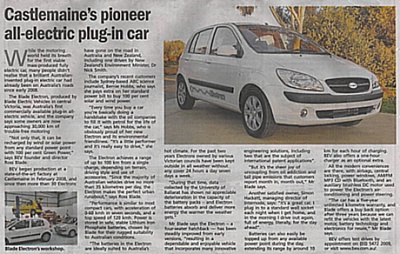

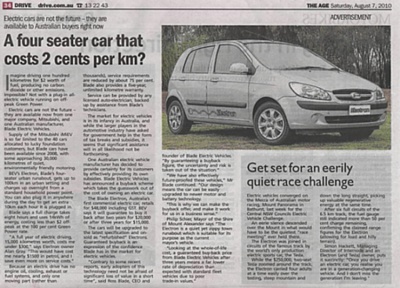

Article in The Age newspaper:
An Australian-designed electric car to be built in China plans to take on the world with a sub-$10,000 price, an iPad like dash capable of downloading apps and the promise of never needing fuel.
Set to debut at July's Melbourne motor show, the Noddy-like EDay hatch will initially arrive next year as 100 lease vehicles before going on sale in 2012 from $9990 (plus on-road costs), undercutting petrol powered competitors by thousands and about 14 per cent of the price of the only mass produced electric car on sale today, Mitsubishi's i-MiEV.
Able to travel up to 160km between charges, it has a top speed of just 80km/h and a weight of 450kg it will be the slowest and lightest new car on the market - and the cheapest, something sure to cement its appeal in a segment where shaving a few hundred dollars can boost sales.
The top secret project is being run by EDay Life, a small Australian company run by former Holden director of innovation and advanced engineering Laurie Sparke and car dealer Robert Lane. The pair have formed a team of 20 designers and engineers and are finalising plans to sell the cars in countries as diverse as Malaysia, Hong Kong, UK and France."What we're bringing ... is Australian innovative technology," says Sparke of the ambitious start-up project. "We are going to develop the new-generation of electric car."
While the prospect of a start-up taking on the established car makers may seem laughable, Sparke says the size, flexibility and clean-sheet approach brings advantages.
Just as fledgling brand Tesla prompted others to take notice - Toyota has since signed an agreement with the Californian electric car specialist - he predicts a rise of next-generation vehicle manufacturers driven from the IT industry, pointing to the Dell computers business model of lean manufacturing.
"If you look at who is driving [the technology behind] electric cars, they're not from the auto industry," says Sparke. "It's the new technology that is coming, and the global [automotive] manufacturers can't respond."
Sparke says a ground-up design allows engineering flexibility while Australian ingenuity - often leveraged by US giants Ford and General Motors with their local operations - and EDay's miniscule size gives it an advantage over established players.
"Currently an electric car is simply the smallest car in a global manufacturer's range. It's had the engine pulled out and an electric motor put in - that's a very compromised solution. An electric car needs to be different in a whole range of ways and we'll develop those in Australia.
The EDay will also get a touchscreen display to control major functions and the ability to download apps that could include everything from basic vehicle data to vehicle-to-home communication
Sparke believes the world will be accepting of an affordable electric car. Already there are various Australian fledgling operations converting conventional hatchbacks into electric vehicles, but the EDay promises to be by far the most affordable.
"Our global advantage is we'll be able to do that in a time frame of three to six months with smart solutions that aren't locked up in the way cars are always being done," he says. "And we'll have globally competitive vehicles."
However, he concedes manufacturing a budget electric car in Australia doesn't make sense, prompting the move to utilise the low manufacturing costs of China, which is fast becoming a global automotive powerhouse. With production set for a Shanghai plant with capacity of 50,000 (and potential for 100,000) EDay plans to sell the cars around the world.
"What we've been very skilled at in Australia the last 20 years is smart engineering. We [Australia] can't manufacture as cheap as China, but we can design, develop, test and certify and that's the automotive business that Australia can do, a world-competitive business."Sparke admits the EDay is a specific vehicle that will sell largely on price and its zero emissions promise.
"We're starting with a car that's fairly mundane," he admits. "But we'll satisfy the market needs because people are eager to have an electric car and its looks are a secondary consideration.
Sparke, who was instrumental in introducing life saving safety features into the Holden Commodore is aware of the mountainous road ahead in a world where profits have slimmed and major brands been forced to change the way they do business.
"Today's challenge is to establish ourselves in the market as a credible supplier of electric vehicles," he says. "To ensure we don't compromise that credibility, we've gone to a lot of effort to monitor this fleet so we don't trip over when we go into a larger volume of production.
"We'll utilise Australian technology and suppliers to do the prototype and testing here. And when we've got a proven solution, we'll send that to our manufacturers in China and they'll produce it."

From The Age drive.com.au 6 January 2011
What does the future hold for your car?
Owen Thomson asks some experts to predict the future of the car for everyday commuters.
Take a good look around the next time you're stuck in traffic. Take a mental picture for posterity. In fact, wind down the window and take an actual picture to show future generations what Western car culture used to look like.
With issues such as rising fuel prices, diminishing fuel supplies and greenhouse gas emissions increasingly dominating our everyday lives, you don't have to be a genius to realise significant change is inevitable. Indeed, experts tend to agree that the next 30 years will be a time of major transformation.
So, if we were somehow able to focus our collective crystal balls on 2040, what type of cars would we see ourselves driving? How would we be getting to work, the shops, the next suburb, the next city?
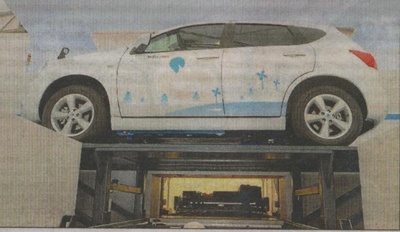
Here's a warning: those hoping for personal jet packs and hover bikes should probably prepare for disappointment.
"Don't think about the future we have seen in Hollywood movies," says Dr Shawn Kook from the School of Mechanical and Manufacturing Engineering at UNSW.
"In 25 years' time you'll have maybe 10 different options to choose from in terms of [car] power plants - diesel, electricity, a hybrid of gasoline and electricity, a hybrid of internal combustiofn engine with fuel cells, a hybrid of fuel cell and battery power. All those multiple choices will be available."
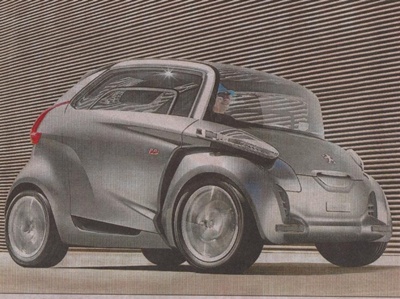
With cars of the future likely to be based on much-improved versions of existing technologies, Dr Kook says the driving force behind new vehicle development will be what he terms a multi-track approach.
"Things that I'm seeing in the future are not things that completely replace the technology that's available now," he says. "The cure for me is this multi-track development methodology for car companies."
"They will have to improve the efficiency of the current internal combustion engine as well as try to develop technology that can use electricity or renewable resources, like solar power."
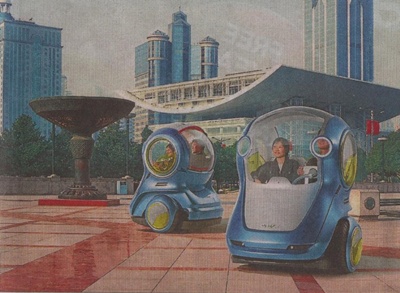
The technical director of the Western Australia Electric Vehicle Trial at the University of Western Australia, Professor Thomas Braunl, also contends that the future is, not surprisingly, electric.
"In terms of 10, 20 years ahead, I think we'll see a significant fraction of all new cars sold being electric," he says. "At first this will definitely be limited to the inner city, so I think the best market for pure electric cars or battery electric cars is going to be as second family cars."
"Once there's consumer interest, a lot of funding will be diverted to that sector and we're going to see an increase in battery capacity and we're going to see rapid-charging technology becoming mainstream."
That's not to say that petrol won't have a role to play for some time yet, however."Petrol is still going to be around for a long time," Braunl says. "It's not going to happen overnight where suddenly everything is going to be electric. The auto industry takes seven years for the development of a new vehicle."
"So 2020 is when we're going to see the second generation of electric cars on our roads. But I think at that time we'll still have a significant amount of cars still being powered by petrol and diesel."
But emerging technologies are set to be only one aspect that will determine the future form of our cars and driving habits. University of South Australia sustainable design expert Professor Steffen Lehmann says it's impossible to consider future commuting models without also taking into account the future forms of the urban spaces we occupy.
Lehmann, who has held the position of UNESCO chair in sustainable urban development for Asia and the Pacific since 2008, contends that Western society has followed the wrong urban development models and that imminent modification of city structures will not only accommodate the use of electric cars but also reduce the need to commute at all.
"We need to transform the city for sustainability, meaning more liveable, more walkable, more pedestrian-focused," Lehmann says, adding that crucial urban redesign initiatives are already under way in places such as Europe and Asia.
"The car will not go away but the car has to become less important in our lives. Electro-mobility will come very fast - much faster than most people think. It will deliver a built environment that is less noisy and less polluted. If you have people getting around without making noise, it's fantastic."
"People can walk and cycle. This will allow planners and architects to build the city differently. This means people can move back into the city centre, open their windows to cross-ventilate their office or apartment."
"This will allow us to transform the city back into what it used to be before the car made it impossible. Electric cars will allow us to have a different lifestyle. In 20 to 30 years, all cities will operate on this premise."
As any futurist will attest, the development of new personal modes of transportation will only be one part of the puzzle when it comes to revolutionising the people-moving problem.
Adventurous public transport options will also be crucial. Already, the not-so-distant future looks impressive, with some international models promising to radically redefine the possibilities for transporting large numbers of commuters simultaneously.
The yet-to-be-constructed, Chinese-developed 3D Fast Bus has been designed to transport passengers above the traffic in elongated capsules that resemble subway cars.
Designed to run on special tracks embedded in the roadway, the electricity-powered bus straddles roads, allowing other vehicles to pass underneath it. The system is predicted to cut congestion by up to 30 per cent.
Chinese scientists are also believed to be developing a next-generation high-speed train capable of speeds up to 1000km/h. Possibly online within a decade, the design utilises maglev (magnetic levitation) technology in an underground airless tube environment, with the total absence of friction allowing for the attainment of enormous speeds.
But while highly ambitious, don't expect to see similar high-tech options in Australia any time soon. Futurist, engineer and researcher Mark Pesce doesn't believe super-expensive VFTs (very fast trains) and maglevs will be viable options here because of our relatively small population.
On the contrary, he predicts a return to the past in the form of modern tram and light rail systems.
"I doubt we'll see high-speed rail or maglev trains in Australia," he says. "I think until we get 75 million people in the country, it's probably not going to be an economically successful idea."
When it comes to the Australian model, Pesce believes the desire to own a mode of personal transport will retain its traditional allure well into the future. And while also contending that the future is largely electric, he believes our addresses will dictate the exact type of vehicle we drive.
He says that while many people living within the urban quarter may still not need a car, "we're going to now start to see how far we can stretch that boundary". Like others, Pesce predicts a mix of vehicle types to populate the roads, as well as the growth of concepts such as readily accessible car rental and car sharing.
"I think the answer is probably not going to be all one or the other," he says of the ideal car-design option. "I think the little cars that people use to shuttle around the inner city will probably be electric because it's just efficient and cheap and you can recharge them at night."
"But I think when you start getting further out and asking 'Is a ute going to be electric powered?' then it's maybe, maybe not. Maybe it's a hybrid. It's probably still getting really good mileage using fuel. What you want to do is get that fuel out to the country where the low-density population will not foul the country up as much."
When it comes to long-distance road trips between major cities such as Sydney and Melbourne, Pesce says future infrastructure and the availability of rapidly replaceable car batteries will also enable us to also rely solely on electric power.
"You'll be able to pull up to a recharging station and have a battery replaced completely mechanically and it'll happen in about 45 seconds," he says, adding that a system just like he describes is set to be deployed in Israel by the American electric car infrastructure company Better Place.
"If you can get 500-600 kms out of a battery, you'd probably just have a big battery-changing station at Albury."
While options for future transport modes are seemingly wide and varied, one question still needs to be asked: is there a chance that changing work habits might largely nullify the need for many of us to commute at all?
Could, for instance, the practice of cyber-commuting and home working eliminate the need to sit in traffic and clog arterial roads in our daily quest to convene at a designated place of work? While easily achievable even by today's standards, it seems this is one option that's unlikely to result in wholesale changes to our driving needs.
"People's desire to own their own vehicles won't change," Braunl says. "People have their habits and they're going to be very difficult to change. I think people are going to go out of their way to try and improve new [transport] technology rather than trying to change their habits. This is basically part of lifestyle."
Pesce agrees.
"For a lot of people, the desire to be social and to be around other people is a very important part of why they work," he says.
"Some people will enjoy working alone and you'll have those kinds of jobs that afford that type of flexibility. But other people will want to work in people environments where there's a lot of one-on-one human contact."
"Like the fuel situation, it won't be a one-size-fits-all solution."

Article in The Age newspaper:
A SHINY new super-car goes on sale in Australia this week, but owning one won't cost a single visit to the petrol station.
The Tesla Roadster is a low-slung, electrically powered two-seat sports car that can be recharged from a household power point for less than $12.
With a range of almost 400 kilometres, depending on driving style, that equates to as little as 3¢ per kilometre.
Super-car status still comes with a super-car price tag, though - owning one will cost at least $206,000 - before on-road costs.
Tesla, a seven-year-old US motoring industry upstart, this week opened a sales and servicing network for the Australian market. The move makes its Roadster the first electric production vehicle officially on sale to the public in Australia.
You only need to service the Roadster once a year, and the technician will come to you.The company's US-based vice-president of communications, Ricardo Reyes, said a showroom and servicing centre would be set up in Sydney, with technicians in other cities.''You don't need to have a shop or service centre on every block to make it work,'' Mr Reyes said.
He said Australia has pent-up demand for the electric soft-top, which will sprint from a stand-still to 100 km/h in less than four seconds. That's up there with Ferrari, Lamborghini and Maserati.
Instead of the fuel-heavy V8, V10 or V12 engine fitted to conventional super-cars, the Tesla has a bank of 6831 mobile phone-style batteries feeding a single electric motor and a one-gear gearbox.
With top speed of 212 km/h, the car can go 394 kilometres between charges.

Article in Herald Sun:
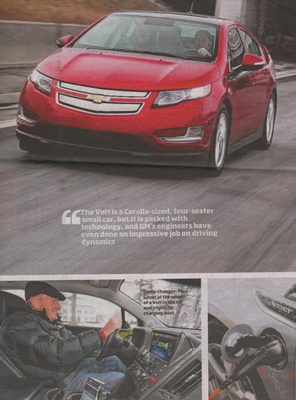
The car of the (near) future is up and running in the USA, and heading for Australian showrooms early in 2012. The Chevrolet Volt is the world's first workable electric car, and one that ends the new-age fear of 'range anxiety' with a hybrid system that turns the Prius world upside-down.
The Volt runs on battery power but has an onboard petrol engine that works as a generator, providing a potential range of more than 600 kilometres and ending the fear of a running 'dry' beyond a plug-in socket.
Holden is an early adopter and plans to have the Volt in its range as soon as possible, although a pricetag estimated in the $60,000 range means it will not be for everyone.
But 'range extender' technology could be a widespread hit, providing plug-in city driving and the chance for long-distance trips using gasoline top-ups along the way. "The Volt can be your one car, your only car," says Mark Reuss, former head of Holden and now leading Chevrolet in the USA.
The Volt is only a Corolla-sized, four-seater small car but it is packed with technology and GM's engineers have even done an impressive job on driving dynamics. It's not a sports car but it's not as dull as a Prius. The Volt has gone from a great idea to a potential game-changer car in less than 18 months, with the first production cars about to be delivered in the USA.
VALUEIt is impossible to rate the Volt without a showroom sticker. The price is likely to be around $60,000 in Australia and that will be costly by any measure. But more and more people are turning to green power and an electric car that can also take a Sydney-to-Melbourne run makes a solid case, with the Prius now priced from $39,990.
The Volt comes with a bundle of value-added stuff in the 'states, including roadside assistance and satnav, as well as a 160,000- kilometre, eight-year warranty on its lithium-ion battery pack.
TECHNOLOGYThere is a vast amount of technology in the Volt but its foundations are all Cruze. The GM compact car provides the foundation and the engineers and futurists do the rest.The heart of the Volt is its heated-and-cooled, 198kg battery pack. It's so big that it's shaped in a tee and steals space between and around the cramped back seat. There is also a 1.4-litre petrol engine in the nose that's responsible for charging duties any time the battery gets severely depleted, or when there is a need for sustained heavy pulling power.
GM originally denied the car ran on anything but electric power but now concedes there is one situation - overtaking under full power beyond 110km/h - when petrol power can briefly turn one wheel. A lot of work has gone into tiny details in the Volt, from its lightweight entertainment system to a horn that gives a polite 'toot- toot' if you nudge the turn indicator stalk.
It's intended for warning work in parking lots and should be fitted to every car. The outcome is simple: GM says the Volt can hit 160km/h and has a 0-100km/h sprint time of less than 9.0 seconds, while happily running with similar range to a petrol-powered car.
DESIGN
The Volt is designed for minimum drag and that means a relatively sharp-edged body that's not unlike a Prius. Stylists have tried to dress the shape but it's still no beauty.
The interior is semi-futurist with a range of digital dash displays, including one that shows how you're driving on an efficiency scale, but with a conventional T-bar shifter to select forwards and reverse. The cabin also has some bright colour trim pieces and leather trim is available, but it is very cramped in the back seat and the hatchback roof glass needs a lot of sun protection to shield people in the rear.
GM has two frontal treatments for the Volt - the Chevrolet corporate look and a much more adventurous design for the Volts sold as an Ampera in Europe - but otherwise it is fairly bland and sensible.
SAFETYThe Volt comes with the usual stuff, including eight airbags, ABS brakes and stability control. GM says the location of the battery pack provides the best possible protection in a collision, with systems to prevent anything nasty escaping or causing a problem in a crash.In America the car is also protected by OnStar, which uses a back-to- base alarm system in the event of a crash, although this is not currently available through Holden in Australia.
DRIVINGMy first drive in the Volt was exactly a year ago, and it was effectively just a lap of the block at GM's technical centre in Detroit. This time there is more than 90 minutes of driving, on freeways and city streets, with a much better chance to know the car. The Volt fires up easily and, despite an icy winter chill in Detroit, the cabin is soon warm without stealing much battery power.
Heated seats help. Pulling into traffic the response is seamless and acceleration is good. The car easily matches or betters other cars in city conditions, and pulls out swiftly to merge onto a freeway.
Cruising at 110km/h is easy and the car is quiet and relaxed. But the lack of engine and driveline noise means you hear other things, like squeaking trim pieces and some thumping and crashing from the rear suspension. The Volt rides as you would expect for a car in the Mazda3-Corolla class, although it takes time to adjust to the artificial brake feel and the steering is a bit over-keen at times.
Generally, the car matches expectations or does a bit better. There are a number of different driving modes and switching to 'sport' sharpens things, as well as providing more regenerative braking. So you only have to lift the accelerator to get a significant slowing.To check the cut-in for the petrol generator engine I deliberately drain the battery by flicking to the 'mountain' mode, which boosts battery reserves. The cut-in is noticeable but the small four is quiet and there is far less noise than a normal car.
All-in-all, the Volt makes a strong second impression. It drives nicely, delivers on its electric promises, and is far more than just a science experiment. When Holden gets the Volt it is going to change the hybrid game and make life very, very difficult for Toyota with its Prius and Camry. It also promises the sort of range and peace of mind that electric car shoppers already crave.
VERDICT
Article in Care2 online:
Electric cars have been around since the 1900s, but it hasn't been until recently that they have really taken off. One of the main reasons for the increased demand of electric cars is due to improvements in technology, but a lot of it also has to do with the increase in oil prices.
Many companies have been creating electric cars on a small-scale basis because of low demand, low efficiency and high cost. Despite many automakers attempting to push their electric cars to the general masses, only 20 percent of consumers would buy an electric car, and only 40 percent of those were willing to pay extra for one.
An Edmunds.com study shows that only 2.7 percent of all cars bought in 2010 were electric, with that projected to increase to 3.7 percent in 2011, 4.1 percent in 2012 and 4.8 percent in 2013.
These low numbers and only slight increases are probably related to uninformed consumers, especially in the actual cost of charging the cars. The cost can vary depending on the location. Charging an electric car in Hawaii, for example, will be equivalent to owning a car that gets 36 mpg, while in Washington state it will be far lower. This is due to the varying cost of utilities in different states.
Besides this, the actual efficiency ratings of these electric cars differ from standard internal combustion engines. While the Nissan Leaf and Chevy Volt advertise a MPG of 93 and 99 mpg, upon closer inspection, the numbers are actually mpg equivalent.
Electric cars' efficiency, like other electronic appliances, is based on kilowatt hours (kwh). For cars, the rate of efficiency is based on kwh per 100 miles. The lower the number, the better the efficiency. The kwh/100 miles is converted to mpg by the EPA to give car owners a basis of comparison to standard automobiles. While the mpg might give buyers a basic idea of savings, to find actual efficiency, kwh/100m should be compared instead.
Besides the cost of an electric car, creating an infrastructure to support widespread usage of these cars is very important. According to Kal Gyimesi of IBV, about 50 percent of the 123 auto industry executives interviewed believe that electric cars will begin to replace traditional cars by 2020. This has led to automotive industries beginning to partner with utilities and startups to help create this electric infrastructure.
Cars could be charged at malls, office buildings and, of course, at home. Even the Prime Minister of India, Manmohan Singh, has begun to push for green car initiatives that would focus on investment in battery management infrastructure, modifying building rules to mandate charging points in large parking lots and developing battery swapping and leasing schemes for electric vehicles.
Washinton, D.C. now has two electric charging stations: one for public use at the Franklin D. Roosevelt Center and another for private use at an apartment complex at 425 Massachussets Avenue. Both are part of the Chargepoint program funded by a $15 million grant from a federal stimulus package.
Currently there are 4,600 other regions slated for Chargepoints development, including: Austin, Texas; Southern Michigan; Los Angeles, California; Manhattan, New York; Orlando, Florida; San Franciso Bay Area, California; and Bellevue/Redmond, Washington.
With increasing infrastructure, growing demand for electric cars and improved technology, it seems that it is only a matter of time before standard automobiles become obsolete.
Toyota plans on developing litium batteries in-house with Tesla Motors, decreasing the cost of cars by almost a third. The company hopes to offer a plug-in version of their Prius in 2012 with a price point below $30,000 (compare that to Chevy's Volt at around $40,000).
Even the 2011 Detroit Auto Show has increased exposure to electric cars, offering a new Electric Car Techzone that occupied 3,500 square feet of showroom space. The area featured cars from Ford, Audi, GM, Toyota and Onstar.
Hopefully the projected 4.8 percent electric car owners by 2013 will actually be much higher, should electric cars actually take root and not be killed off like in the 1900s.

From Care2 online:
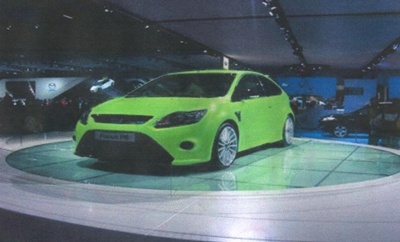
Developing electric vehicles is important in reducing greenhouse gas (GHG) emissions. American vehicles are responsible for almost half of the GHGs emitted by vehicles globally, but make up 30 percent of cars in use, according to a 2006 report by Environmental Defense.
Transportation accounts for 30 percent of U.S. GHG emissions and five percent of global emissions, according to a 2010 report by the U.S. Department of Transportation. In 2006, GHG emissions from on-road vehicles accounted for 79 percent of transportation emissions, and 59 percent were from light-duty vehicles, which includes passenger cars and pick-up trucks. Increasing fuel economy is suggested in the report as one way to reduce GHG emissions from transportation. Completely electric vehicles such as the Focus Electric go one step further: they eliminate the need for fossil fuels.
“Electric Vehicles will bring about new ways of refueling,” a 2010 Ford press release stated. “Instead of topping off the tank with gasoline, customers will plug in.”
Ford tripling production of electric vehiclesThe Ford Motor Company is tripling production of five electric vehicles in North America through 2013. Ford will build 100,000 electric vehicles by 2013, 35,000 more than it currently manufactures.
One of the five electric vehicles is the Ford Focus Electric. Ford describes the vehicles as the “first fuel-free, rechargeable passenger car from Ford.” Derris Kuzak, group vice president, Global Product Development, says of the Focus Electric, “Its advanced powertrain will deliver significant energy efficiency advantages and zero CO2 emissions without compromising driving enjoyment. And its suite of smart driver information technologies will transform the way customers think about energy usage and their transportation needs.”
“Customers have come to expect fuel efficiency with every new vehicle Ford delivers today, and now we are further differentiating our electrified vehicle lineup with something else people truly value – choice,” said Jim Farley, Ford’s group vice president of Marketing, Sales and Service.

Article in The Herald Sun newspaper:
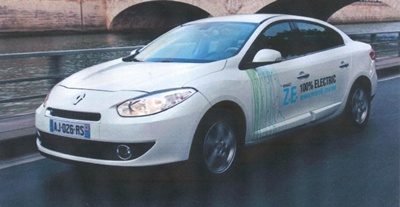
Renault promises the car will cost much the same as a petrol version of the Fluence, which means less than $30,000.
ELECTRIC cars are finally started to make a spark in Australia with Renault joining the plug-in movement ...
... that already includes Mitsubishi, Nissan, BMW and Mercedes-Benz.
Renault is taking a shortcut by converting its four-door Fluence sedan, already on sale in Australia with a petrol engine, to electric power and expects to add extra models as they become available from France.
But there is a big twist - Fluence Z.E. buyers will only pay Renault for the car and will then sign a contract with the Better Place organisation for their battery and energy supplies.
Renault promises the car will cost much the same as a petrol version of the Fluence, which would mean less than $30,000, but no-one is talking yet about the other costs or the exact rollout of the charging points and battery-swap locations that Better Place said will eliminate the 'range anxiety' that hangs over the future of electric cars.
"Our vision is clear. The overall cost of ownership must be equivalent to an internal-combustion car," said Justin Hocevar, managing director of Renault Australia. "Sales of the Fluence Z.E. will begin before the end of 2012."
The Renault move comes less than a week after Mitsubishi set the price of its very basic iMiEV plug-in car at $48,800 and following the commitment by its global Nissan-Renault alliance partner, Nissan of Japan, to a dedicated electric car called the Leaf.
The Nissan, too, is expected in Australian showrooms next year. Renault and Better Place are short on any real detail beyond the basics of the Fluence E.V. and a commitment to a national rollout of charging infrastructure that will start soon in Canberra.
"I'm very confident that the vast majority of electric car drivers will be able to drive wherever they want and whenever they want," says Evan Thornley of Better Place. He said that long-term supply deals for renewable energy, starting in Canberra, mean that electric car drivers will have more certainty on their long-term running costs than drivers of petrol-powered cars that face the uncertainties of oil company pricing.

Article in The Age newspaper:
A dozen charging stations for electric cars are likely to be installed in the CBD. Photo: Reuters
IN A Victorian first, charging stations for electric cars are likely to be installed at 12 on-street parking spaces in Melbourne's city centre, as part of a program being introduced by the Department of Transport.
Melbourne City councillors will tomorrow vote on a plan to work with the department to alter a dozen metered parking spaces in the CBD to make way for electric car recharging devices.
Each metered parking space earns the city $10,000 a year in parking fees. But the council, which is likely to approve the plan, will not lose money as a result of installation of the electric vehicle recharging spaces.
A report to be presented to the council's Future Melbourne committee tomorrow says the loss of parking revenue ''will be compensated by the conversion of other on-street spaces … to metered parking''.
The 12 parking spaces will either be 30-minute ''fast-charging'' spots, or two-hour standard recharging locations.
Lord mayor Robert Doyle said it was important, if motorists were to have faith electric cars would one day be widely popular in Australia, that people started to see infrastructure being introduced.
''You need visible demonstration projects to show people that this is not some wacky idea of the future; this is with us right now,'' he said.
The council would try to find high-visibility spaces on busy streets, he said, so that people would notice electric cars being recharged. Electric cars are starting to enter the Australian car market. Although still expensive, the cars have zero exhaust emissions, lower running and maintenance costs, and are much quieter.
Holding back the increase in market share for electric cars is ''range anxiety'' - driver concern that they will run out of power in the middle of a trip. Most electric cars can travel about 120 to 150 kilometres before needing to be recharged. There is also concern about the standardisation of chargers.
The Department of Transport is running a five-year trial of electric cars. Earlier this year, 60 households were given electric cars from one of five manufacturers, to drive for three months and report back on their experiences.
The new on-street parking spaces are expected to be installed by January, if the move is approved by the council.

Article in The Age newspaper:
By Lawrence MoneyMelbourne City Clowncil was voting last night on our first on-street recharging stations for electric cars. Clean, green electric, it’s the only way to go, eh? So how come Australia’s only home-grown electric car maker, Blade Electric Vehicles, of Castlemaine, has been locked out of this week’s International Motor Show?
“We tried for months to get a response from the show organizers,” says company chief Ross Blade. “Eventually I was told that the board, comprising the major international motor manufacturers, had met and our name came up and it was voted that we should not be permitted to exhibit at the show.”
“They, of course, have their electric product in the show but we are the only Australian electric vehicle maker. Our Blade Electron has been on the road since 2008. They know about us and we were quite shocked that they used that veto.”
The Blade company imports Hyundai Getz car bodies then fits electric drive systems. “Our vehicles sell for $47,000 plus on-road, which compares very favourably with the international companies whose electric cars are all above 50k.” The Blade Electron can reach 80km/h and travels an estimated 100 kilometres around the city on one charge.
What does the Motor Show say? Nothing, really. Show HQ flickpassed me to the VACC but, ay close of play, our queries had gone unanswered.

Article in the Sydney Morning Herald Weekend Drive:
This week we examine BMW's vision for a smart urban future, speed cameras getting removed and Mazda's sleek new compact city crossover.
How BMW is reacting to its belief that global warming will change the way cars are built, sold and driven.
Car makers typically guard future model plans like the crown jewels. Vehicles are camouflaged, proving-ground gates are padlocked and media inquiries are batted back with the standard company line: ''We don't discuss future product.''
They do it because they don't want to telegraph their punches to the opposition and they don't want customers to hold off buying the current model in anticipation of the arrival of a new and improved one.
But in the brave new world of electrification, the old rules have been turned on their head. BMW last week spilled most of the beans on its first electric vehicle and hybrid supercar.
At a media briefing that rivalled the most extravagant of motor show reveals, the Bavarian luxury brand stunned the media with near-production versions of its new i3 electric city car and its i8 supercar; two cars that won't hit showrooms until late 2013 or early 2014.
This sudden impulse to talk about future products speaks volumes about the rapid pace of change in the automotive industry. Not so long ago, BMW's jewels in the crown were fire-breathing sports cars or big, fat limousines with lazy V8s.
But the world's dwindling oil resources have changed the game forever.
A board member and head of marketing and sales for BMW, Ian Robertson, says the pace of change is unprecedented.
''The car industry is roughly 100 years old; the next 10 could be more changeable than we have seen in that hundred years,'' he says. ''We could see more volatility and more change to our processes, more change to our technology and more change to the way our industry behaves than in the last hundred.''
He says cars will be manufactured differently, made of different materials, sold and marketed differently and even used differently.
The upcoming i3 is a case in point. Its aluminium floorpan and chassis is made largely from recycled soft drink cans, its carbon-fibre-reinforced plastic bodyshell contains recycled soft drink bottles and some of its cabin fabrics are made from hemp.
If that's not enough change, consider this: the two-piece body structure - an aluminium frame containing the chassis and drivetrain and a carbon-fibre-reinforced plastic (CFRP) passenger cell - is glued together, not welded.
The factory in which it will be built even uses natural lighting to reduce its electricity bills.
Once it is available to the public, there mightbe a number of i3 drivers who don't own the car but merely pick it up from a parking spot identified by their smartphones and drop it off elsewhere when they are finished with it.
''If you look at Tokyo, the vast proportion of under-25-year-olds who could have a driving licence don't, and they don't because all the parking spaces are gone and you needa parking space to have a car,'' Robertson says.
The idea of providing those people with mobility when they want it for a limited period is a strong business model, he says.
''People still want individual mobility. There's no question, no question about it in our mind. But you have to find new solutions for that.''
Yet, as BMW has found, the more the needs of customers change, the more they stay the same.
People want emissions-free motoring but not at the expense of convenience. And a field trial with 750 electric MiniE owners confirmed many wanted more range than the typical electric car could provide (typically 150 kilometres or less).
.''We did a lot of research with MiniE and we had 750 cars running in real customers' hands doing everyday real things and the average commute for an urban dweller is around 30 kilometres,'' Robertson says. ''Now these cars are fine for 30 kilometres but if you look at the weekend requirements - particularly in the large cities in the United States, where you might live in Los Angeles in the week but you might want to go to Tahoe at the weekend - then you need to have an ability to respond to that.''
Enter the range extender, a General Motors innovation that has appeared in the Chevrolet Volt and has proved a hit in the US, where a large part of the Mini trial was done. The range extender is a small petrol engine that doesn't power the wheels but acts merely as a generator to recharge batteries when they run low.
The range-extender model in effect does away with so-called range anxiety, a big barrier to customer acceptance of electric vehicles. However, it is also a less environmentally friendly solution and means - as vehemently as marketing departments try to tell people otherwise - the car becomes a hybrid, not a true electric vehicle.
''You need to have that ability to give a range extender,'' Robertson says. ''I do think that over the next few years, plug-in hybrids will probably gain much more traction than full battery-electric vehicles because of their more universal application.''
That's why the electric i3 will come with an optional petrol engine. Those familiar with BMW's penchant for an extensive list of costly options on their cars can't help but see the humour in the fact that the brand now makes even the engine an option.
No doubt executives at Lexus - which has led the way on hybrid technology in the luxury segment - will allow themselves a wry smile.
Robertson denies the decision to offer a range-extender option was a recent one based on feedback from MiniE customers.
''We always had this as an idea in our mind,'' he says.
However, when BMW announced the formation of its environmentally friendly ''i'' range in Geneva this year, it made no mention of a ''range-extender'' petrol engine in the i3, despite revealing detailed specifications of the car. Now, four months later, the option is buried deep in the 50-odd page media release on thenew ''i'' range.
Why is the German brand so reluctant to admit that it might have been an afterthought?
Probably because, despite the marketing spin that it is leading the electric revolution, BMW is relatively late to jump on the idea of electric propulsion for motor vehicles.
Honda and Toyota have had hybrid vehicles for more than a decade and General Motors, Nissan, Mitsubishi, Renault and the Peugeot-Citroen group have electric vehicles on sale in various markets. Many more will join the party before the i3 and i8 go on sale in late 2013.
BMW argues that some electric vehicles have been rushed to market, in effect, and are based on existing petrol-car platforms (Audi and Mercedes-Benz are adapting existing conventional platforms for their electric vehicles).
BMW is pushing the tagline ''born electric'' to market its i3 and i8; the idea being that while competitors have merely added electric motors to existing petrol cars, BMW has developed its electric cars from the ground up.
The company says that gives it advantages in packaging, because its cars don't have to accommodate an engine at the front, a driveshaft going through the cabin, a petrol tank and an exhaust system.
That also allows the Munich-based brand to build a relatively small car with a surprisingly spacious cabin - something like Dr Who's TARDIS .
A board member and head of development for BMW, Dr Klaus Draeger, is openly critical of some of the electric cars that have been built on petrol-car platforms.
''Conversions are always a compromise,'' he says. ''We can offer roominess on a very small floor space.''He says the ground-up approach - and the use of expensive carbon fibre - has saved between 250 and 350 kilograms.
Robertson also rejects suggestions the brand is playing catch up on eco-mobility.
''I think we're leading in many, many respects,'' he says. ''We still have one of the largest fleets of electric vehicles in real customer hands.
''Our knowledge is really at an advanced stage from real customer usage.
''These two cars [i3 and i8] are born electric. They were not conceived for something else. They weren't conceived to have an engine and then at some point we took the engine out and put a battery in or an electric motor in. We drew these from the ground up for an environmental-technical change point that we see as important in our industry.''
They might be late to the party but the new cars are impressive in their use of cutting-edge technology and materials.
The cars are like none that have come before them. The widespread use of expensive CFRP for the passenger cell is revolutionary, as is the idea to glue - or cold bond - the passenger cell to an all-aluminium frame that holds the vehicle's suspension, battery, drive systems and chassis.
It's not just the construction of the car that is revolutionary. The new ''i'' range will be part of a radical ''eco-mobility'' strategy for the company and it goes beyond simply selling cars, delving into real-time navigation and smartphone apps that avoid traffic snarls and find parking spots in congested cities.
The company will also be involved in car-sharing schemes.
The Frankfurt briefing gave more details about engine outputs and range for the two new cars, with BMW revealing it has ditched the small diesel engine from its EfficientDynamics supercar concept in favour of a three-cylinder petrol engine that will better suit the production i8's sporty character.
The i3, on the other hand, will have an electric motor over the rear axle, generating 125kW of power and 250Nm of torque - or pulling power - available from standstill. If the optional range-extender petrol engine is ordered, it will sit next to the electric motor and add another 100 kilograms to the weight of the car, reducing electric-only range and affecting performance.
BMW has stuck with the rear-wheel-drive layout as a point of differentiation with other electric vehicles and hybrids, which are predominantly driven through the front wheels and typically less than involving to drive.
BMW says the i3 concept will accelerate from 0-60km/h in less than four seconds and from 0-100km/h in less than eight seconds.
The battery can be fully recharged in six hours from a standard 240-volt power socket, or to 80 per cent capacity in an hour using a high-speed charger. Like many other electric vehicles, the i3 will be able to cover between 130 and 160 kilometres solely on battery power.
The company also revealed more interior design details for the two cars, including that the i3 will have bench seats that allow everyone inside to slide across and exit on the one side if it is parked in a tight spot.
The back doors are rear-hinged, making access to the seats easier, while there are luggage compartments in the back and front.
The i8, meanwhile, has its electric-drive system mounted over the front wheels, with a 162kW, three-cylinder turbocharged petrol engine driving the rear wheels.
The electric motor in the i8 can power the car for up to 35 kilometres, which will allow it to enter some city areas under electric power only, avoiding congestion charges.
Working in tandem with the petrol engine, it produces a claimed output of 260kW.
BMW says the car will accelerate from 0-100km/h in a sports car-like 4.6 seconds but use less fuel than a Prius, at 2.7 litres per 100 kilometres on the European fuel cycle, which is similar to the Australian calculation.
The lithium-ion battery can be charged from a domestic power supply and replenished during driving by a regenerative system that captures and stores kinetic energy usually lost when braking.
Despite the revolutionary carbon fibre-infused body, the i3 is not light for its size. It weighs about 1260 kilograms, or about the same as a Toyota Corolla or Mazda3. It is, however, considerably lighter than the Nissan Leaf electric car, which tips the scales at 1521 kilograms.
BMW claims CFRP is as strong as steel but about 50per cent lighter. By comparison, aluminium is 30per cent lighter than steel.
Both cars have the latest driver-assistance technology, including automatic parking, plus a low-speed ''traffic jam assistant'' that can automatically steer, accelerate and brake at speeds of up to 40 kilometres.
BMW won't be drawn on pricing for either car, although the i8 is expected to cost supercar money ($300,000).
The i3 will be priced at a premium over other electric cars, which suggests a price tag of anywhere between $60,000 and $80,000. Those prices condemn both cars to niche status and ensure neither are likely to make much of a dent in global warming.
But they will give a warm, self-satisfied glow to the people lucky enough to afford them.

BMW has published the results of its 12-month Mini E trial in Britain, which reveals nearly all of the study’s participants would consider purchasing an electric vehicle.
The trial consisted of 138 London residents – who were probably chosen carefully by Mini – sharing 40 Cooper-based Mini E models and covering more than 400,000 kilometres.

The data was collected electronically by data-loggers in the car and home charging points. The findings are likely to influence the development of BMW’s dedicated electric-vehicle model, the i3 city car, scheduled for launch in 2013.
About 30 per cent of the respondents said they would consider buying an EV within the next year but 55 per cent said they would wait two years or more.
When it came down to living with the electric Mini, the average daily distance was almost 50 kilometres.
Four out of five respondents said the two-seater would be suitable for 80 per cent of their needs if a rear seat and larger boot were added (occupied in present models by a bank of batteries).
The Mini E is powered by a 150kW electric motor and a 35kWh battery pack with a claimed real-world range of 180 kilometres.

Article in the The Saturday Age Drive:
Croatia has become a holiday hot spot for its myriad islands and warm Adriatic waters but it has never been known as an automotive powerhouse - perhaps until now.
Rimac Automobili is a start-up electric-supercar company with big ambitions. Its stunning ''Concept-One'' two-seater coupe is designed to compete with Audi's E-Tron, BMW's i8 plug-in hybrid, Mercedes-Benz's SLS AMG E-Cell and other zero-emission supercars from Porsche, Fisker and Tesla.
But the Concept-One has some serious performance figures to rival these competitors. How does 800kW of power, a staggering 3800Nm of torque, a 0-100km/h time of just 2.8 seconds and a self-governed top speed of305km/h sound? Oh, and a 600-kilometre driving range between charges.
These are the official figures the Zagreb-based company claims, courtesy of four electric motors to power each wheel and what it calls an ''all-wheel torque vectoring system'' that varies the amount of torque sent to any wheel for maximum traction.
Ten 92kWh lithium phosphate batteries are positioned throughout the car for optimum weight distribution, while the sleek body is made from carbon fibre for an impressive kerb weight of just 1650 kilograms, or a bit less than a Holden Commodore Omega sedan.
Recharging times are not mentioned but the car's charging point is on the front three-quarter panel.
The chief executive of Rimac Automobili, Mate Rimac, started the business in 2009 after developing the company's first ''mule'' car, an electrified E30 BMW M3 that produces more than 400kW.
''Our first car evolved in a short period of time into a project that didn't give a final result - instead, it was a start, the start of the world's first electric hypercar, the Concept -One,'' Rimac says.
''We started with a blank sheet of paper. The idea was to create an exceptional supercar with a new propulsion concept.''
The company says the production version of the Concept-One - its first model - will be limited to 88 units, with deliveries beginning in 2013.

The following article was in The Age (Drive.com.au) newspaper:
French brand takes the conventional sedan and gives it an electric make-over with the convenience of battery exchange.
Two new cars point to the future of motoring. Drive gets behind the wheel of the Volkswagen Up and the Renault Fluence ZE.
A debate is raging in the automotive industry. To plug in, or not to plug in – that is the question. Around the world, car makers are busy working out how the industry can survive as oil reserves dwindle.
Almost all are intensively investigating electric propulsion on the one hand, while also trying to slash the fuel use of conventional cars on the other.
Whether it’s “urban-focused” city vehicles that aim to move the masses in compact comfort, or plug-in passenger cars with batteries that can be swapped like gas bottles at the service station, the automotive industry is attempting to cover every base as it prepares to face a resource-constrained future.
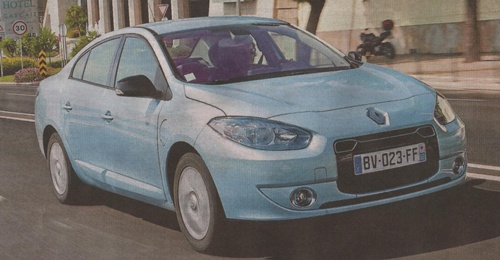
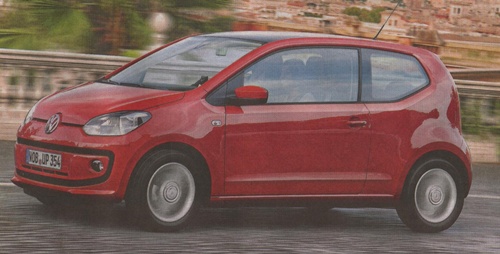
Drive has tested two very different takes on the automotive future. Renault’s Fluence Z.E. (Zero Emission) is a medium-sized electric-powered sedan that looks and feels like a regular three-box family car; meanwhile, Volkswagen’s new Up micro car is a four-seater hatchback with a frugal three-cylinder petrol engine.
The Up is designed with the daily commute in mind but with the ability to hit the freeway without any anxiety.
The Fluence Z.E., on the other hand, has a claimed average electric range of 185 kilometres. That means buyers will, effectively, be confined to the suburbs, unless their longer-distance drive route includes a battery-swap station along the way.
Renault says the Fluence Z.E. will offer a car that’s useful for day-to-day driving. It is based on an existing petrol-powered sedan but switches the combustion engine for an electric motor and a switchable battery pack.Figures from the Australian Bureau of Statistics suggest 95 per cent of drivers typically don’t exceed 120 kilometres in a day. Most cars spend between 20 hours and 22 hours parked, time that can be used for charging.
It’s a relatively similar story for urban commuters elsewhere in the world. That’s why brands including Nissan and Renault predict plug-in cars will make up 10 per cent of cars on the road by 2020.
In Australia, Renault plans to offer the Fluence Z.E. with a unique battery-leasing model that will work much like a mobile phone subscription. Buyers of the car won’t pay for the batteries that power it, cutting about $15,000 from the price and eliminating resale anxiety about the battery pack’s limited lifespan (about eight to 10 years).
The batteries will remain the property of electric car infrastructure company Better Place, which also supplies the charging points.
The plan, details of which are yet to be announced, is expected to be similar to one now offered in Denmark. Fluence Z.E. buyers there pay a one-off €1000 ($1330) set-up fee that includes a home recharging unit and unlimited access to charging points and battery switch stations throughout the country.
They will have access to a range of services, including smartphone apps and computer programs that allow them to plan their trips, and the Fluence Z.E. will feature a satnav system developed specifically for the car. Users will also pay a monthly levy based on how many kilometres they travel and all electricity used from charge points, including the home ‘‘wall box’’.
Volkswagen offers a more low-tech but no-less-important solution with the Up.
With a conventional petrol-powered three-cylinder engine driving its front wheels, a chunky three-door hatchback body and the choice of a manual or automatic five-speed gearbox, the Up doesn’t immediately scream ‘‘game changer’’.
But to drive it is to understand it is a small car that is more than the sum of its parts. In terms of performance, quietness, ride quality, interior roominess and overall refinement, it is a vast step forward in the sub-light car class.
Volkswagen Australia promises a starting price of less than $15,000 when the Up arrives here towards the end of next year. It has made room in the VW range by discontinuing the three-door version of the slightly larger Polo Trendline, which was priced at $16,690 (plus costs).
Volkswagen spokesman Karl Gehling says the time is right for the company to bring the smaller Up to Australia. ‘‘The Australian market has tipped more towards downsizing and we see an opportunity to take advantage of that trend,’’ he says.
‘‘In particular, because of the Up’s interior packaging and available space, we think it will be very well received.’’
However, just how the cheapest Up will be specified is not clear. Features such as standard airconditioning, power windows, electronic stability control and four airbags are a given.
But Volkswagen hasn’t yet shown its cards on whether the Up will be powered by the 44kW or 55kW version of the 1.0-litre three-cylinder or if the five-door version – due for European launch in December next year – will be part of the range at launch.
Low fuel use is expected of a car its size and the Up presents a beautiful set of figures. The 44kW version achieves a claimed 4.5 litres per 100 kilometres and emits 105g/km of CO2, dropping to 4.2L/100km and 97g/km in the miserly BlueMotion version fitted with low-rolling-resistance tyres and a stop-start system for city driving.
Another version of the Up, powered by compressed natural gas and fitted with the BlueMotion package, goes even better, delivering 2.9L/100km and 79g/km of CO2 – but it won’t be offered in Australia. There are no plans for an LPG Up.
While Up owners won’t have to change the habits of a lifetime – apart from not going to the petrol station as often – adopters of Renault’s electric vehicle will need to make adjustments.
The head of external relations for Better Place Australia, Alison Terry, says customers of its electric vehicles, including buyers of the Fluence Z.E., will need to change the way they think about getting from A to B.
‘‘People will have to learn a very different way of driving,’’ Terry says. ‘‘We’ve had more than a hundred years of combustion engines and filling your car up once or twice a week but this is different.’’
She says electric cars can offer a better value proposition than conventional petrol cars, particularly as petrol prices rise in the future. ‘‘At the moment, if you’re spending $80 a week on petrol, you will be better off,’’ she says.
That’s based on electric cars requiring less maintenance as they have fewer moving parts – there’s no need for oil, fuel and air filter changes. The cost of ownership is about 20 per cent lower than a conventional car.
Terry says there will be three main types of adopters: the ‘‘inner-city greenies ... probably from Balmain or Brunswick’’, who would consider buying an electric car – no matter what the cost – to ‘‘do their bit for the environment’’.
Then there are the outer-suburban ‘‘Commodore or Falcon’’ families that spend about $100 on petrol a week, whom she says ‘‘are the people who will gain the most’’ because of the lower cost of ownership. Finally, fleet buyers will make up most sales as a means of reducing their carbon impact and to save money.
The chief executive of Better Place Denmark, Johnny Hansen, believes the cost of fuel is going to continue to rise and electric cars are a way for buyers to steer away from paying more at the pump.
‘‘None of us have any expectations of prices of diesel or gasoline going down; we expect it to go up,’’ Hansen says, suggesting a forecast growth in demand from countries such as India and China will push prices higher around the world.
‘‘In Denmark, the total roll-out of the Better Place project is €100 million – that’s comparable to four days of gasoline in this country. So is that big infrastructure? Is that a big investment?’’
Unlike Australia, Denmark already has significant government-backed incentives in place for green cars such as the Fluence Z.E. Like all electric cars, it attracts no registration tax, whereas conventional cars attract fees of up to 180 per cent of the purchase price.
That means a Chevrolet Cruze (similar to the Holden version) costs 375,000 kroner ($67,000), whereas the similarly sized electric Renault is available for just 205,000 kroner.
In Australia, no incentives are in place for electric vehicles, so petrol cars remain vastly more affordable in most cases. But unlike mainstream electric competitors such as Mitsubishi’s $48,800 (plus costs) i-MiEV and Nissan’s circa-$60,000 Leaf, the larger Renault has been confirmed to start ‘‘in the high $30,000s’’ with ‘‘a high level of specification’’.
Volkswagen’s new baby will be even cheaper – less than half the price – but is far from nasty.
At 3540 millimetres long, the Up is more than half a metre shorter than the Polo light car. Yet with a wheelbase of 2420 millimetres, it packs plenty of interior space. The two rear seats have ample headroom and just enough space for longer legs, and the boot will take plenty of shopping bags or even a suitcase or two.
Performance from the 44kW version of the three-cylinder engine is more than adequate when accelerating through the gears, despite Volkswagen’s claim of an extremely modest 0-100km/h time of 14.4 seconds.
Tall gearing means there’s not much pulling power in fifth gear (the engine barely ticks over at 2600 rpm at 100km/h) but the viceless manual gearshift ensures swapping cogs is more a pleasure than a chore.
An optional automatic transmission – an automated version of the five-speed manual with a single clutch, rather than VW’s usual dual-clutch arrangement – will also be offered but none were available to drive at the launch.
The 55kW Up adds more sparkle to the driving experience. In either version, the main impression is the engine is quiet even when revved hard, so any preconceptions of this being a downmarket buzz-box are banished quickly.
Softish suspension that delivers a comfortable but controlled ride, quality switchgear and high levels of fit and finish add to the impression of a car lacking in size, not substance.
Still, plenty of hard plastics are on the dashboard and the steering column is tilt adjustable only. There’s no central bin between the front seats, either, but they are about the only negatives in what is an open, light and airy cabin.
Beauty is always a subjective concept but the program director for the Fluence Z.E., Nicolas Remise, says the fact the Renault doesn’t have the quirky styling of some electric competitors is an advantage.
‘‘We’re doing nearly normal cars because we’re targeting really high volumes,’’ Remise says.
‘‘The Renault model is to achieve the same retail price as for the internal combustion-engined equivalent car.’’
Renault’s strategy takes into account that most European nations – unlike Australia – have incentives in place for electric vehicles. Remise says buyers who can’t get any government assistance will have to bear the brunt of the purchase price but he hopes high demand will drive a drop in production cost and enable companies to lower upfront purchase costs.
‘‘We believe we have a business model that is probably more successful than selling the customer everything [including the battery pack],’’ he says.
Drive’s first experience of the Fluence Z.E. indicates Renault could be on to something. It turns a conventional sedan into something slightly more unconventional but without any significant compromise for most day-to-day commuters (see breakout).
A spokeswoman for Renault Australia, Emily Ambrosy, says the French brand and Better Place are committed to working together in Australia.
‘‘Fluence is the first project: we’ve announced it together, we’re working together, we’re working on roll-out together and we’re committed that customers will have the infrastructure to back up their electric cars, because you need to in order to make it a practical solution,’’ she says.
Some European nations have other incentives to encourage electric-car ownership, such as free parking and congestion toll exemptions.
The business development manager for electric vehicles at Renault, Thomas Orsini, says these perks are valuable in drawing buyers to alternative modes of transport such as electric vehicles.
‘‘Things like bus-lane exemptions have a huge psychological impact,’’ Orsini says. ‘‘People think they have an advantage and they like that.’’
One of the biggest criticisms of electric cars is the fact that, for Australia at least, most electricity production is ‘‘dirty’’, derived from burning brown coal. However, Renault and Better Place say the plug-in cars they offer will not be powered by unclean sources.
The managing director of Renault Australia, Justin Hocevar, says the Fluence Z.E. will ‘‘tick all the boxes for a wide variety of car users’’.
‘‘Our aim with the Fluence Z.E. is to take away as many of the remaining excuses as to why you can’t switch to renewable energy [and] zero emissions for your mobility needs,’’ Hocevar says.
It is the first mass-produced car with the ability to swap one battery for another. Renault says it will produce more cars in the future with the same technology, including the Zoe city car – a vehicle for which the company has very high hopes.
Remise says the car will be a ‘‘blockbuster’’ in sales volumes, a sentiment echoed by Hansen of Better Place. ‘‘There’s no doubt the Zoe will be the No.1-selling car in [Denmark]. No doubt,’’ Hansen says.
Volkswagen is also upbeat about the Up’s future and after a first drive on the streets of Rome, it’s clear anyone expecting pain in downsizing to a car this small will be in for a pleasant surprise.
Just as the Golf and Polo deliver excellent driving experiences for a little more money than cars within their size bracket, the Up goes beyond expectations. To drive, it’s a thoroughly together – even entertaining – little car.
Which type of car will win the hearts and minds of consumers? An overall victor will be unlikely – not within the next decade, anyway – as brands leave no stones unturned and no technology unprobed in their search for increasing efficiency.
Coming soonThe Renault Fluence Z.E. and the Volkswagen Up are the tip of a fuel-efficiency iceberg. Amultitude of zero-emissions, hybrid and ultra-efficient city cars are either already being sold elsewhere or known to be in the final stages of development. Some may arrive here within the next five years. Here’s a look at what else is around.
Electric Vehicles
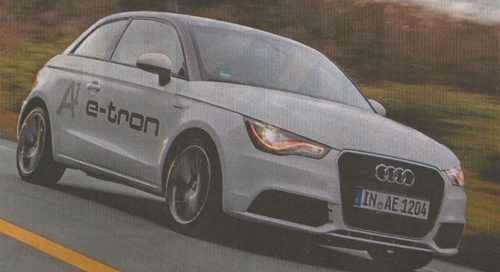
The ageing body of the A3 luxury hatch hides a future-focused electric drivetrain. Forget that you're looking at an Audi A3 - it's what lies beneath its ageing body that counts.The all-electric A3 e-Tron is yet another strong indication of the VW-owned brand's electrification plans for the near future.
The German luxury brand has made no secret that by 2020 it aims to offer an "e-Tron" alternative powertrain variant of its entire model line up.
Audi's first e-Tron model will be the R8 electric supercar, which goes into small-scale production late next year with Australian deliveries expected about six months later.
At the other end of the scale are two "technology studies" that have yet to receive production approval: they are the A1 e-Tron, an electric car with a tiny petrol-engined range extender to overcome "range anxiety"; and this, the A3 e-Tron. Drive sampled each e-Tron prototype for just six kilometres in Hakone, Japan last week.
Revealed at the Los Angeles motor show last week, Audi describes the A3 e-Tron as "an all-around vehicle for future mobility".
Unlike the A1 e-Tron that uses a modest-sized electric propulsion system and a rotary engine to recharge the battery on the run, the A3 e-Tron employs a more powerful electric motor and more batteries to power it.
"We thought about other solutions ... one of them is a range-extender solution and we have the A1 to test this," product strategy boss for Audi e-Tron Heiko Seegatz says. "And we have the A3 battery electric [vehicle] to test another solution."
Though a concept, the A3 e-Tron's looks are even more understated than the smaller e-Tron sibling.
No fancy wheels or headlight details; it even has a conventional ignition barrel to start the electric motor. Unlike the A1 e-Tron's fancy recharging socket located behind the front logo, the A3 e-Tron's plug socket is positioned where you'd usually pump petrol into the car.
Under the bonnet, the electric unit supplies 60kW of continuous power and a peak of 100kW for short bursts during overtaking. Maximum torque, or pulling power, is 270Nm and available instantly for a noticeable shove in the back. Power is delivered to the front wheels via a single-speed automatic transmission as in the A1 e-Tron.
The lithium-ion battery is stored in blocks under the boot floor, rear seat and in the transmission tunnel. It stores 26.5kWh of usable energy and weighs 300 kilograms for a kerb weight of 1592kg - almost 140kg more than the heaviest A3 currently on sale, the all-wheel-drive 2.0 TFSI five-door hatch (1455kg).
Audi says the A3 e-Tron can be recharged in about nine hours from a household socket, or four hours on rapid charge. On a single battery charge, it can cover about 140 kilometres and sprints from 0-100km/h in 11.2 seconds (1.0 second slower than the A1 e-Tron). However, its electrically limited top speed of 145km/h is 15km/h faster than its sibling.
Our all-too-brief six kilometre sample behind the wheel of the A3 e-Tron revealed the typical electric car smoothness and silence and brisk acceleration from the word "go".
On the move, the ambience was disrupted by some wind noise and winter tyres fitted to our test car that made a loud thrumming sound over the smooth tarmac. A tyre change should be an easy fix.
The drive can choose from four brake settings which noticeably adjusts the degree to which the electric motor recovers energy during braking and coasting. The first setting feels much like any other car, while the fourth provides more aggressive "engine" braking as soon as you take your foot off the accelerator.
Curiously, the adjustment for the brakes was traversed via the gearbox paddle shifters - an odd placement that is presumably best put down to the fact these cars are still in the prototype phase.
So, when will a "real" A3 e-Tron be available? Audi isn't saying yet, though it has been widely reported that a production version is expected by 2014.

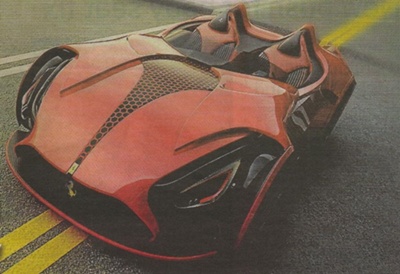
With the age of the electric car fast approaching, many believe it's a golden opportunity to bin conventional car design and start with a clean sheet.
Regular mechanical engineering doesn't necessarily apply to zero-emissions vehicles, so why not design them accordingly?
That's what Marko Petrovic argues with his Ferrari Millennio - an electric supercar design study, inspired by modern architecture and the Ferrari World theme park in Abu Dhabi.The futuristic-looking building is said to be the world's largest indoor park and hosts the world's fastest roller-coaster and a G-force ride that catapults riders up 62 metres and back down.
The Millennio is influenced by the building's intricate interplay of different surfaces, textures and materials.
The car's front and rear are inspired by the lines of the Italian supercar maker's models, reinterpreted with a mix of different elements.
The lightweight, two-seat supercar is theoretically powered by two electric motors, while the intricate exterior would be made from advanced materials such as buckypaper.
Claimed to be 10 times lighter and more than 500 times stronger than steel, buckypaper is an ultra-thin sheet made from an aggregate of carbon nanotubes.
It is currently undergoing tests for armour and fire-fighting applications. The exterior also includes a silicon layer that gives extra protection.
The Serbia-based industrial designer believes the visual design progress of electric cars is much slower than their technical development.
''Ferrari needs to maintain their philosophy of making the best and fastest cars in the world,'' Petrovic says. ''But will the [need for] speed be so dominant in the future?''
Petrovic believes future-generation Ferrari owners may not be so familiar with speed and performance but rather the sense of owning a piece of art.

The following link is to an article in Huffington Post about electric vehicles due in the next year - from 2010 onwards:

DVD: "Who Killed the Electric Car? (2006)
Available in Australia


RED JOS BLOGSPOT (from January 2009 onwards)
Red Jos: HUMAN RIGHTS ACTIVISMMannie's blogs may be accessed by clicking on to the following links:
MannieBlog (from 1 August 2003 to 31 December 2005)
Activist Kicks Backs - Blognow archive re-housed - 2005-2009
RED JOS BLOGSPOT (from January 2009 onwards)

This page was created on 28 JULY 2010 and updated on 11 FEBRUARY 2013
PAGE 62